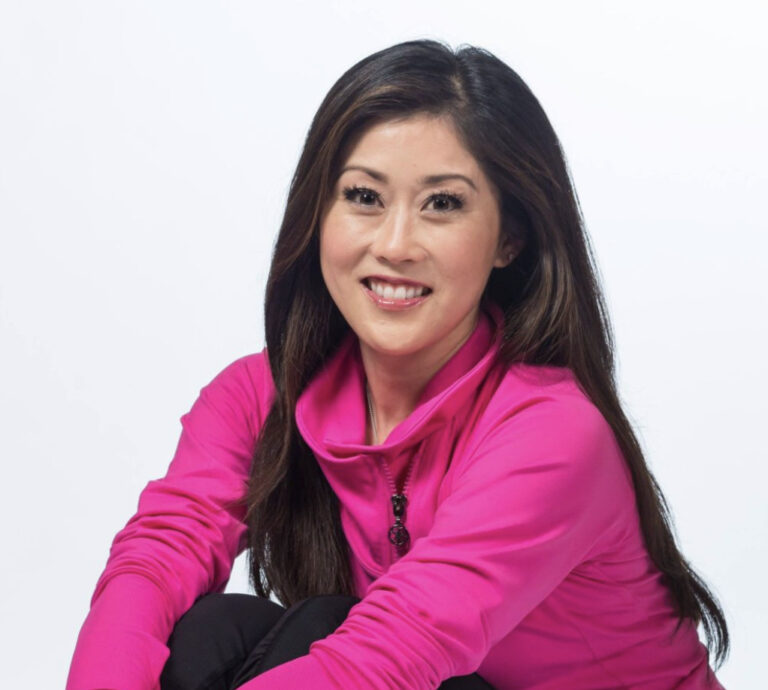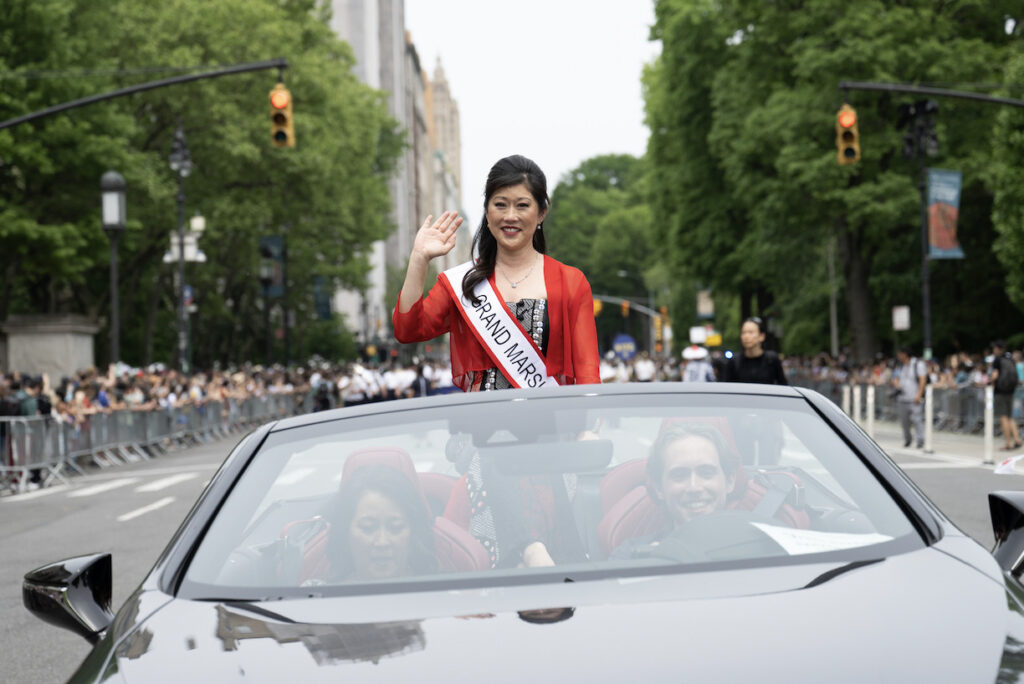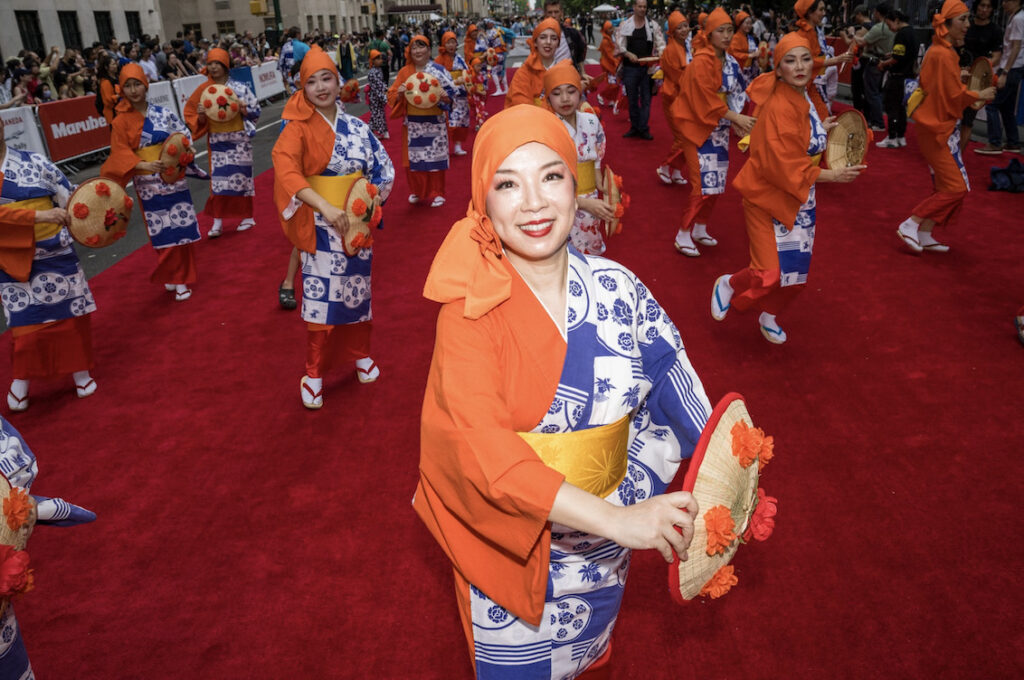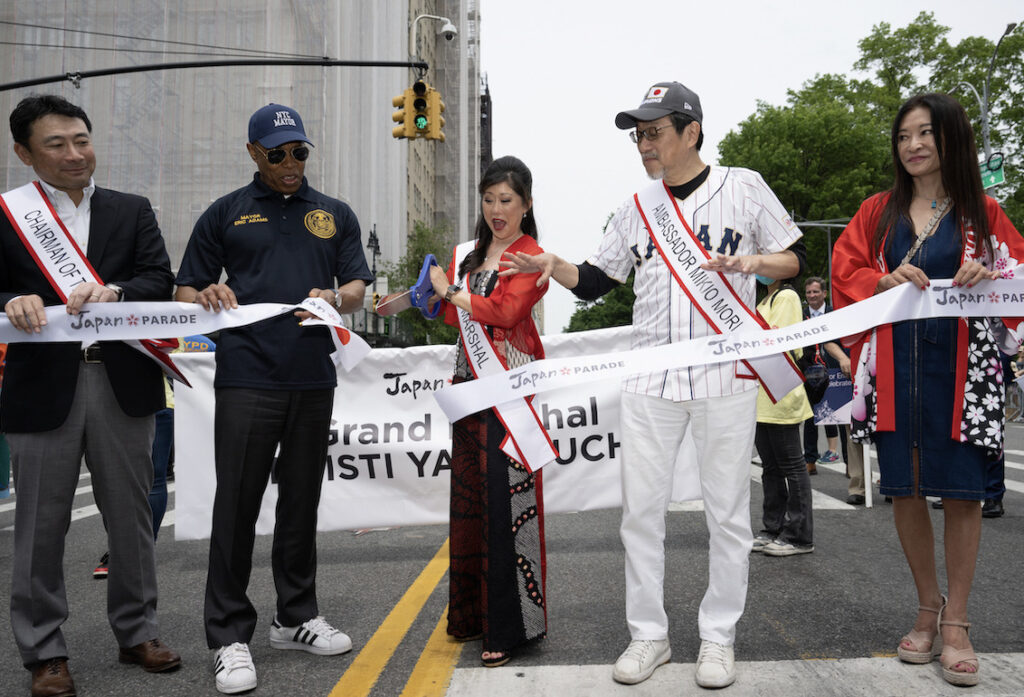
Recently, I had a chance to talk to Kristi Yamaguchi who attended the Japan parade.
At the 2nd annual Japan Parade in New York City which took place on Saturday, May 13. Starting from Central Park West at West 81st Street to West 67th Street, the purpose of the parade is to celebrate, express, and bring awareness to the friendship between NYC and Japan with a thank you from the Japanese community. Olympic Gold Medalist, Founder of Always Dream, and Author Kristi Yamaguchi was the Parade’s Grand Marshal.
Exclusive Interview with a former Figure Skater Kristi Yamaguchi
Q : Your roots are set in your grandparents initially coming from Japan. They spent time in an internment camp during World War II. Did they talk about what their life was like back then?
K.Y : My grandmother on my mother’s side was born here in California. My grandmother’s experience was an interesting one. Her husband was fighting for the US in Europe. Though she originally didn’t have to be in the internment camp, she found that it didn’t feel safe and she couldn’t get a job or anything so she decided to join her family in the camp. At least her family was there and when she found out she was pregnant, she felt safer to be in the camp. It was a tough one because she was pregnant and there was uncertainty, it was hard because her family lost everything.
They were flower growers before the war and had some property. She tried to keep their family house, but it got shuffled in the mix after the war with other family members. She lost the family house and everyone pretty much had to start over. It was similar on my dad’s side. With my dad’s family, he was about five years old when he was in the camp, from five to eight years old when he and his family were there. I think he was so young. He just thought it was fun with his family and school friends — he made new friends. But it was harder, he said, on his older brothers and sisters, because they were teenagers. For them, it was a lot tougher. After they were released, they had to resettle, find their footing again, and work really hard in order to make a living again.
Q : When you were born, you had a condition with your foot, bilateral clavicle foot. What kind of challenge did you face? What kind of physical therapy did you go through to improve your body and start skating because that was like an important turning point for you in your early life?
K.Y: I was very fortunate that my parents did the corrections early on. From the time I was two weeks old, I had plaster casts on both legs and every two weeks I had to go back and get new casts put on because babies grow so fast. The new casts were for trying to straighten out my legs. For about 18 months, I had to have the casts and then after that, corrective shoes with a bar in between the feet to turn out my feet even more.
I do remember that part — my legs were often sore and achy and my dad had to massage them, especially at night. It was hard to sleep with the bar on. I didn’t know anything different. I just did it. By the time I was probably three or four, they were pretty well corrected. It encouraged me to start different activities to help with coordination.
Q : You started skating around four or five years old and then, when you were in the sixth grade, you started doing this really rigorous training starting at like 5 to 10 am. You were a hardworking, active person who practiced those things, but at the same time, your mother, your parents, had to get up early to take you to skating. What kind of relationship did you develop with your mother who supported you in all those things. It’s not just yourself that is doing the hard work, but also parents as well.
KY: My mom was as dedicated as I was for sure. I’ve always felt so fortunate and lucky every day that she was willing to do what it took for me to skate and go after my dreams. It was every day, six days a week, so early in the morning. She had to travel with me to various competitions, either driving long distances or flying across the country. That meant my dad had to pick up the extra slack too, because I had a brother and sister at home.
He looked after them through junior high and high school to make sure they were getting to their activities and things were looked after. It definitely was a whole family affair and my mom had to sacrifice a lot in order to get me to the rink and make sure I got my lessons, skating equipment and whatnot. She had to look after lots of things. We were very close. She was my biggest supporter and shared in so many of the experiences that I had as a skater.
Q : You competed at such an early age, you had to go certain places to compete. You had to do homeschooling. What did you go through as a child, when it came to academic schooling, and all that? What were the challenges that you faced?
K.Y: I went through regular school up through junior high school. And then, in eighth grade, I was probably about 12, I did have a full-time tutor. That was tough because I really missed being in a classroom. For my first two years of high school, I did purely independent studies. It was through the school system, the school district, but I only had to go in once a week to take tests, get my new assignments and turn in my previous week’s assignments. During the week, I had a week’s worth of work to do on my own. It was hard because it took a lot of self-discipline.
For skating, the self-discipline came easily because I loved what I was doing and was motivated. It was my passion but then to try to do the school work on my own was a lot harder. I got through it but I did want more social interactions so with my junior and senior years in high school, I did go back on campus to a high school in Fremont, my hometown. I was there for only three classes, but it was enough to be in that environment and learn with other students and have a teacher every day. That stimulation, I really enjoyed that part of it. I did take three classes still through independent study for that flexibility so I could train until 10 or 11 in the morning. I was lucky that high school allowed for a flexible hybrid schedule.

Photo credit: Carla Torres/AP Images for Japan Day, Inc.
Q : You started with a junior title with Rudy Galindo. How did you meet him? What kind of approach did you have when you practiced? You have to be in sync when you’re doing pair skating.
KY: We met when we were very young. He was 13 and I was 11. He had just won the novice national men’s title. So he was already a national champion for the novice. Everyone knew him at the rink. He was a big deal and I think we were both very tiny at that age.
Q: I was surprised when I looked at your profile. At the Olympics, you were at least like 5’10 or something. Your performance was big and overwhelming. You were big in stature.
KY: When we started pairs we were both really small and people at the rink were like, “Oh how cute, they’re both so little like they look cute — they would look cute skating together. So we started just for fun as an 11- and 13-year-old but we were both very strong single skaters. When we paired together, we did really well and I think better than we even expected.
Within a couple of years, we were already skating at the national level and having pretty good success. And we were having fun. That was good. But it was a good thing that we were young because we had the energy to train as single skaters and as pair skaters together. We really only trained about an hour a day as a pair team, which isn’t very much considering how far we got.
Q : In 1991, you moved to Edmonton, Alberta, Canada, to train with coach Kristi Ness. How did you make that decision? What was it about her coaching that differed from the others?
K.Y: All of that came about because she got married and her husband was from Edmonton. Obviously, she was going to go up there to be with him. I wanted to continue to train with her.I followed her up to Edmonton. We were just very fortunate that at the time, Edmonton was pretty much a hotbed for figure skating. Many of the top Canadian coaches were there. A lot of the top Canadian skaters were training out of Edmonton as well as national champions from other countries.
The Swedish national champion was there, as were the Danish national champion, and Australia’s national champions. It was a very elite training center and it worked out better than expected. I have very, very close friends that I made while I was in Edmonton. It was fortuitous that her husband ended up being there. It was good because, also, by being away from home, it forced me to grow up a little more, become more independent and take charge of my goals in skating and what I had to do in order to compete and be ready.
Q : What was it like competing with Nancy Kerrigan and Tonya Harding back then, particularly after you won the 1991 World Championship. You were the top three American members. You, Tonya Harding and Nancy Kerrigan won. It was a sweep of the world podium until like 2021. It’s impossible to win the sweep by all the American skaters. It’s really tough to compete with others. What was like competing with them back then?
K.Y : It was good. It was so competitive in our country that it pushed each of us to keep improving and get better. We easily saw what our top competitors were doing. We just had to look at each other and be like, She’s doing that. I had to push myself to do that or do more. It was high pressure, obviously, in the U.S. Championships because it was hard to even get to the world championship but at the same time we pushed each other and it forced us to get better and better. On that note, Nancy Kerrigan and I had known each other since we were novice competitors. We were very, very good friends and had just known each other for a long time and were roommates. Even though we competed against each other, it was a unique situation that we were also pretty good friends.

Photo credit: Carla Torres/AP Images for Japan Day, Inc.
Q : Even though you already turned professional, how did you hear about this incident at the 1994 Olympic between Tonya Harding and Nancy Kerrigan? What was your initial reaction? What did it mean for the figure skating community back then?
K.Y : Initially, it was pure shock that something so violent like that could happen. Obviously, I had concern for Nancy knowing it was so close to the Olympics. She was the big favorite to lead the US team, but also to medal and possibly win. It turned into a huge scandal circus where people who normally never even were interested in skating were all of a sudden interested to see this drama play out. It couldn’t put more of a spotlight on our sport at that time. It was interesting because I was a professional on the other side and understandably the competitors were very insulated so they weren’t really allowed to talk about it much and didn’t want to focus on it.
They wanted to focus on preparing and training and being ready for the Olympics. A lot of the press and media turned to us as professionals because we were able to speak about it more freely. In other ways, it was a little crazy for a couple of years, the spotlight on figure skating was really intense. In some ways that was good, in some ways bad. I think the good thing is that people were interested. They were watching skating. There were lots of events for us to perform in and take part in. Even to this day the sport still is recovering from the negative [pall] that it cast over the sport.
Q : After you won the Olympic gold medal, how did you maintain who you are? It’s so difficult when people are coming at you. It just turns your life around in a way so how did you stay grounded? You did pretty well it seems compared to some other people who have had a scandal or some other issues [after winning].
K.Y: I would have to credit my support system for sure, starting with my family. They’re very grounded. They obviously were very proud of what I had accomplished, but they never lowered their expectations of the kind of person who they wanted me to be, the values, the integrity, all were still set high. My parents were like, “Never rest on your laurels, never take anything for granted, always be grateful for what comes your way.” My family kept me grounded. I had a really great support system of people who I really trusted — my agent, my coach and choreographers. I had a lot of trust in them and they were really good people. I was fortunate for that. Not everyone has a team of people around them that truly have the athlete’s best interest at heart. That helped me keep me on a good track.
Q : Being Japanese, what do you think about the skater Midori Ito? She’s one of the best figure skaters ever. Tonya Harding and Midori Ito were consistently landing difficult triple axel jumps in competition. Instead of going for that jump, you became an all-around skater. Talk about that decision to go that direction.
K.Y : First off, I have to say Midori was incredible and she’s responsible for taking women’s figure skating to a different level. She was the first one to incorporate so many triple jumps in her programs and pushed us to keep up with her technically. She set the bar and her power is unmatched. Even to this day, she jumped so high — like almost half her height — which was incredible. I was always glad when I didn’t have to practice with her because everyone was just so awe-inspired by her. I knew I had to come up with a counter way to compete with her.
I was really working hard on the triple axel and was very close, but it wasn’t mastered in time for the competitions before the Olympics. I knew I had to find a different way to compete with everyone — with her and Tonya. I had to execute more on the presentation, the composition style, and the interpretation of the music. That was as important and I had to make that my strength in order [to compete].
I also knew the triple lutz, the triple toe was a must because even though it wasn’t the triple axel, it had a value that was close or equal to it. If I had that, plus the artistic mark in my favor, then I would have a chance. It could have gone either way for sure. If everyone skated clean with all the triple axels, I also knew that those would be risky jumps for both Tonya and Midori. It was more of a gamble for them. I knew if I could skate clean and have that, then that was my only chance.

Photo credit: Carla Torres/AP Images for Japan Day, Inc.
Q : After you turned pro, you were collaborating with other skaters doing Stars on Ice. You’ve been doing that for more than a decade. What is it like representing all the skaters doing the stars on ice to make people unfamiliar with skating and to inspire kids who want to skate.
What do you do when you do a Stars on Ice?
K. Y: It was just so incredible to be a part of Stars on Ice. At the time, it was [made up of] the best professional skaters in the business. There wasn’t a better entertainer than Scott Hamilton .
Q : He not only jumps like crazy but does very acrobatic things.
K.Y : Right. Jumps, personality, and charisma. I watched him get standing ovations every night from the excitement, skill and fun he brought to the ice. Joining the ranks with him and Brian Orser, Katerina Witt, Torval and Dean, I learned so much from these incredible skaters. It was so much fun to be able to push ourselves artistically.
We had our medals already, but what could we bring to audiences that was different from being a competitor? That was by creating a story and moving the audience in a different way. Whether it was contemporary music, fun pop music or doing something with the Beatles. It was always very, very creative and a dream to be a part of it. There wasn’t anything that we could venture into and try.
Q : You did “Dancing with the Stars,” which you won in the sixth season. What was it like working with Mark Ballas when you were paired together? What kind of rigorous training did you have to do? Was it easy to tap into your figure skating to dance, or was it totally different?
K.Y : The one similarity I would say is that when you’re performing to music, musicality definitely helps. I wouldn’t necessarily say every skater has musicality. I happen to be one of the skaters who I zoned into the music and performed to it. From the waist down, the legs and the feet are totally different. In skating, we’re gliding and it’s smooth and it’s isometric holds — things like that. Whereas in dance, it’s eight count beats and syncopation.
The steps are so much quicker than you would ever do on the ice. In that regard, it was a lot different. Obviously you’re with a partner. If you’re not used to working with a partner, get used to that as well. But Mark Ballas was just incredible, patient and so creative with the choreography. We had a blast. It was so much fun to do that.
Q : You made appearances in TV shows such as “Everybody Loves Raymond,” “Fresh Off the Boat,” and “Hell’s Kitchen.” You also acted in films like “The Mighty Ducks” and a Disney Channel’s movie.
How did you familiarize yourself with acting? What was your approach? What was the challenge that you faced with acting?
K.Y: I don’t feel I was a very good actor. I never was trained or had any instruction. It wasn’t comfortable at all but I really enjoyed it. If I was playing myself, that was OK. It was fun to do some small things like “Fresh off the Boat” and “Everybody loves Raymond.” It’s not like I had a whole lot to remember or do so those were fine.
It’s fun to do small things like that, but to have the patience of mind to remember lines and be an actor in a full episode or something — that’s different.
Q : You also wrote a children’s book, “The Dream Becomes Little Pig,” which was really well received among actually lots of readers. What made you decide to write a children’s book? You have a foundation called Always Dream Foundation for Children. You seem very good at working with children. What inspired you to write a children’s book? How did you establish the foundation for the Always Dream Foundation for Children?
K.Y : My kids really inspired me to write a book, a children’s book, for them. They loved their story time before bed. We had quite a routine of reading books. They would pull out their favorite ones to read and I thought, “I would like to write a story for them to have and to remember someday that mom wrote this for them.” That inspired “Dream Big Little Pig” and the messages that were in that book as well as its followup, “Big World Little Pig” and my third book, “Care is Kindness.” always wanting to have some positive take away from the books.
Becoming an author inspired the direction of Always Dream. We established it back in 1996 and did various things. Around 2012, we really turned our focus on the early literacy after I had become an author and realizing how critical it is to develop the love of reading, of books early on, in order for there to be a foundation that the child can really grow their education on, build their education on, and their dreams on. It was shocking to learn that over 60% of low-income families don’t have children’s books in the home. They can’t have story time like our kids had every night. I wanted to provide access and a way for kids to go after their dreams through education. That’s the direction I’ve always dreamed of — providing access leveling the playing field after their dreams.
Q : You’ve done a lot of things — writing children’s books, appearing on the TV show Dancing and all those things, not just figure skating. Is there anything that you want to pursue right now or do something different from what you have been doing?
K.Y : I probably should start asking myself. I feel like I’m pretty busy with dreams and the trajectory of growth that we have planned in front of us and are really digging in there. I do want to continue writing children’s books so a fourth one has been a long time coming. It’s time to really sit down and come up with a plan for another book. I would love to continue writing and doing some more children’s books and who knows what else. I’m open to whatever might come along.

Photo credit: Carla Torres/AP Images for Japan Day, Inc.

